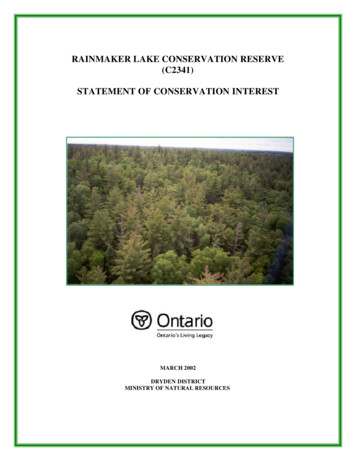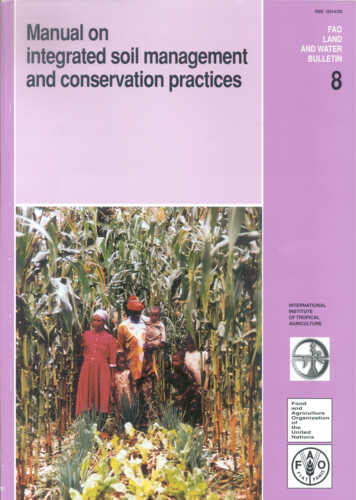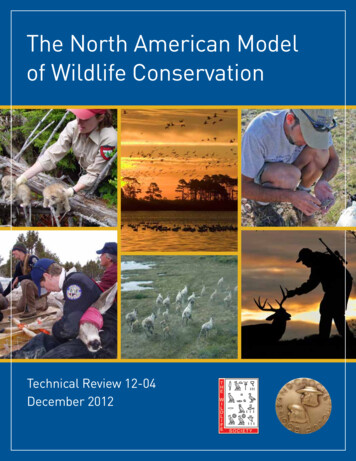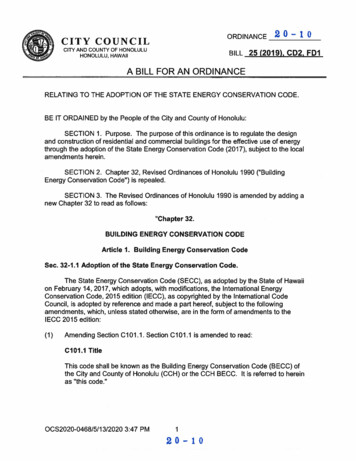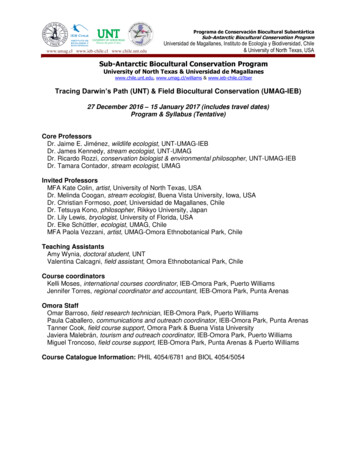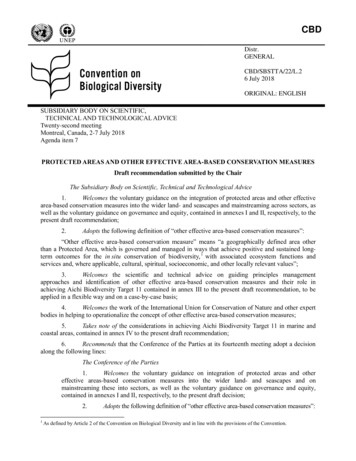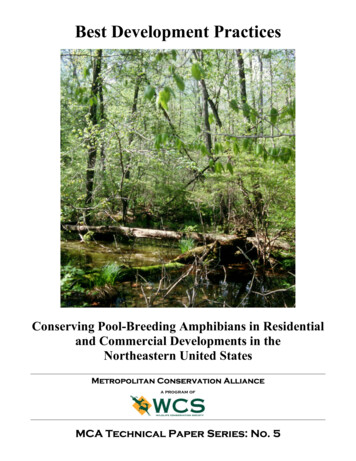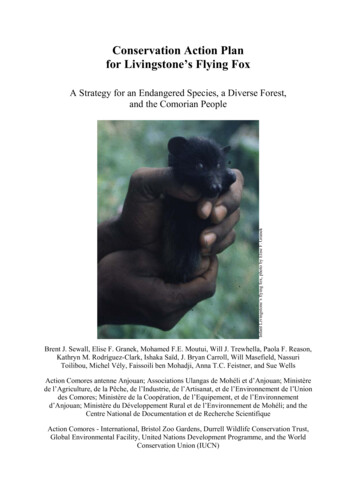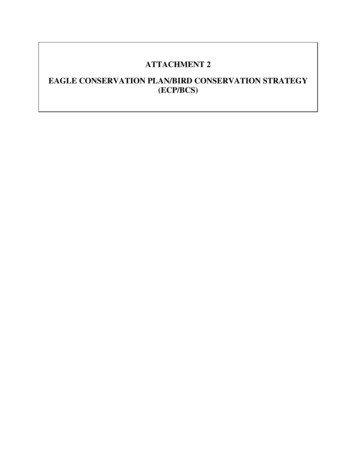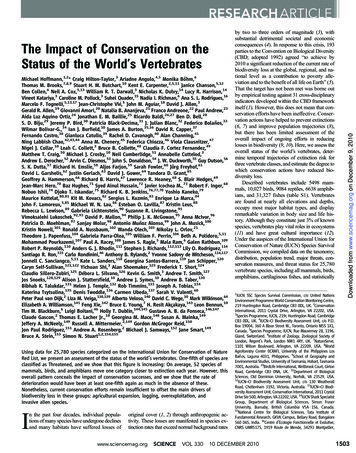
Transcription
The Impact of Conservation on theStatus of the World’s VertebratesMichael Hoffmann,1,2* Craig Hilton-Taylor,3 Ariadne Angulo,4,5 Monika Böhm,6Thomas M. Brooks,7,8,9 Stuart H. M. Butchart,10 Kent E. Carpenter,2,5,11 Janice Chanson,5,12Ben Collen,6 Neil A. Cox,5,13 William R. T. Darwall,3 Nicholas K. Dulvy,14 Lucy R. Harrison,14Vineet Katariya,3 Caroline M. Pollock,3 Suhel Quader,15 Nadia I. Richman,6 Ana S. L. Rodrigues,16Marcelo F. Tognelli,5,13,17 Jean-Christophe Vié,5 John M. Aguiar,18 David J. Allen,3Gerald R. Allen,19 Giovanni Amori,20 Natalia B. Ananjeva,21 Franco Andreone,22 Paul Andrew,23Aida Luz Aquino Ortiz,24 Jonathan E. M. Baillie,25 Ricardo Baldi,26,27 Ben D. Bell,28S. D. Biju,29 Jeremy P. Bird,30 Patricia Black-Decima,31 J. Julian Blanc,32 Federico Bolaños,33Wilmar Bolivar-G.,34 Ian J. Burfield,10 James A. Burton,35,36 David R. Capper,37Fernando Castro,38 Gianluca Catullo,39 Rachel D. Cavanagh,40 Alan Channing,41Ning Labbish Chao,42,43,44 Anna M. Chenery,45 Federica Chiozza,46 Viola Clausnitzer,47Nigel J. Collar,10 Leah C. Collett,3 Bruce B. Collette,48 Claudia F. Cortez Fernandez,49Matthew T. Craig,50 Michael J. Crosby,10 Neil Cumberlidge,51 Annabelle Cuttelod,3Andrew E. Derocher,52 Arvin C. Diesmos,53 John S. Donaldson,54 J. W. Duckworth,55 Guy Dutson,56S. K. Dutta,57 Richard H. Emslie,58 Aljos Farjon,59 Sarah Fowler,60 Jörg Freyhof,61David L. Garshelis,62 Justin Gerlach,63 David J. Gower,64 Tandora D. Grant,65Geoffrey A. Hammerson,66 Richard B. Harris,67 Lawrence R. Heaney,68 S. Blair Hedges,69Jean-Marc Hero,70 Baz Hughes,71 Syed Ainul Hussain,72 Javier Icochea M.,73 Robert F. Inger,68Nobuo Ishii,74 Djoko T. Iskandar,75 Richard K. B. Jenkins,76,77,78 Yoshio Kaneko,79Maurice Kottelat,80,81 Kit M. Kovacs,82 Sergius L. Kuzmin,83 Enrique La Marca,84John F. Lamoreux,5,85 Michael W. N. Lau,86 Esteban O. Lavilla,87 Kristin Leus,88Rebecca L. Lewison,89 Gabriela Lichtenstein,90 Suzanne R. Livingstone,91Vimoksalehi Lukoschek,92,93 David P. Mallon,94 Philip J. K. McGowan,95 Anna McIvor,96Patricia D. Moehlman,97 Sanjay Molur,98 Antonio Muñoz Alonso,99 John A. Musick,100Kristin Nowell,101 Ronald A. Nussbaum,102 Wanda Olech,103 Nikolay L. Orlov,21Theodore J. Papenfuss,104 Gabriela Parra-Olea,105 William F. Perrin,106 Beth A. Polidoro,5,11Mohammad Pourkazemi,107 Paul A. Racey,108 James S. Ragle,5 Mala Ram,6 Galen Rathbun,109Robert P. Reynolds,110 Anders G. J. Rhodin,111 Stephen J. Richards,112,113 Lily O. Rodríguez,114Santiago R. Ron,115 Carlo Rondinini,46 Anthony B. Rylands,2 Yvonne Sadovy de Mitcheson,116,117Jonnell C. Sanciangco,5,11 Kate L. Sanders,118 Georgina Santos-Barrera,119 Jan Schipper,120Caryn Self-Sullivan,121,122 Yichuan Shi,3 Alan Shoemaker,123 Frederick T. Short,124Claudio Sillero-Zubiri,125 Débora L. Silvano,126 Kevin G. Smith,3 Andrew T. Smith,127Jos Snoeks,128,129 Alison J. Stattersfield,10 Andrew J. Symes,10 Andrew B. Taber,130Bibhab K. Talukdar,131 Helen J. Temple,132 Rob Timmins,133 Joseph A. Tobias,134Katerina Tsytsulina,135 Denis Tweddle,136 Carmen Ubeda,137 Sarah V. Valenti,60Peter Paul van Dijk,2 Liza M. Veiga,138,139 Alberto Veloso,140 David C. Wege,10 Mark Wilkinson,64Elizabeth A. Williamson,141 Feng Xie,142 Bruce E. Young,7 H. Resit Akçakaya,143 Leon Bennun,10Tim M. Blackburn,6 Luigi Boitani,46 Holly T. Dublin,144,145 Gustavo A. B. da Fonseca,146,147Claude Gascon,2 Thomas E. Lacher Jr.,18 Georgina M. Mace,148 Susan A. Mainka,149Jeffery A. McNeely,149 Russell A. Mittermeier,2,149 Gordon McGregor Reid,150Jon Paul Rodriguez,151 Andrew A. Rosenberg,2 Michael J. Samways,152 Jane Smart,149Bruce A. Stein,153 Simon N. Stuart1,2,154,155Using data for 25,780 species categorized on the International Union for Conservation of NatureRed List, we present an assessment of the status of the world’s vertebrates. One-fifth of species areclassified as Threatened, and we show that this figure is increasing: On average, 52 species ofmammals, birds, and amphibians move one category closer to extinction each year. However, thisoverall pattern conceals the impact of conservation successes, and we show that the rate ofdeterioration would have been at least one-fifth again as much in the absence of these.Nonetheless, current conservation efforts remain insufficient to offset the main drivers ofbiodiversity loss in these groups: agricultural expansion, logging, overexploitation, andinvasive alien species.In the past four decades, individual populations of many species have undergone declinesand many habitats have suffered losses oforiginal cover (1, 2) through anthropogenic activity. These losses are manifested in species extinction rates that exceed normal background rateswww.sciencemag.orgSCIENCEVOL 330by two to three orders of magnitude (3), withsubstantial detrimental societal and economicconsequences (4). In response to this crisis, 193parties to the Convention on Biological Diversity(CBD; adopted 1992) agreed “to achieve by2010 a significant reduction of the current rate ofbiodiversity loss at the global, regional, and national level as a contribution to poverty alleviation and to the benefit of all life on Earth” (5).That the target has not been met was borne outby empirical testing against 31 cross-disciplinaryindicators developed within the CBD frameworkitself (1). However, this does not mean that conservation efforts have been ineffective. Conservation actions have helped to prevent extinctions(6, 7) and improve population trajectories (8),but there has been limited assessment of theoverall impact of ongoing efforts in reducinglosses in biodiversity (9, 10). Here, we assess theoverall status of the world’s vertebrates, determine temporal trajectories of extinction risk forthree vertebrate classes, and estimate the degree towhich conservation actions have reduced biodiversity loss.Described vertebrates include 5498 mammals, 10,027 birds, 9084 reptiles, 6638 amphibians, and 31,327 fishes (table S1). Vertebratesare found at nearly all elevations and depths,occupy most major habitat types, and displayremarkable variation in body size and life history. Although they constitute just 3% of knownspecies, vertebrates play vital roles in ecosystems(11) and have great cultural importance (12).Under the auspices of the International Union forConservation of Nature (IUCN) Species SurvivalCommission, we compiled data on the taxonomy,distribution, population trend, major threats, conservation measures, and threat status for 25,780vertebrate species, including all mammals, birds,amphibians, cartilaginous fishes, and statistically1IUCN SSC Species Survival Commission, c/o United NationsEnvironment Programme World Conservation Monitoring Centre,219 Huntingdon Road, Cambridge CB3 0DL, UK. 2ConservationInternational, 2011 Crystal Drive, Arlington, VA 22202, USA.3Species Programme, IUCN, 219c Huntingdon Road, CambridgeCB3 0DL, UK. 4IUCN–CI Biodiversity Assessment Unit, c/o P.O.Box 19004, 360 A Bloor Street W., Toronto, Ontario M5S 1X1,Canada. 5Species Programme, IUCN, Rue Mauverney 28, 1196,Gland, Switzerland. 6Institute of Zoology, Zoological Society ofLondon, Regent’s Park, London NW1 4RY, UK. 7NatureServe,1101 Wilson Boulevard, Arlington, VA 22209, USA. 8WorldAgroforestry Center (ICRAF), University of the Philippines LosBaños, Laguna 4031, Philippines. 9School of Geography andEnvironmental Studies, University of Tasmania, Hobart, Tasmania7001, Australia. 10BirdLife International, Wellbrook Court, GirtonRoad, Cambridge CB3 0NA, UK. 11Department of BiologicalSciences, Old Dominion University, Norfolk, VA 23529, USA.12IUCN–CI Biodiversity Assessment Unit, c/o 130 WeatherallRoad, Cheltenham 3192, Victoria, Australia. 13IUCN–CI Biodiversity Assessment Unit, Conservation International, 2011 CrystalDrive Ste 500, Arlington, VA 22202, USA. 14IUCN Shark SpecialistGroup, Department of Biological Sciences, Simon FraserUniversity, Burnaby, British Columbia V5A 1S6, Canada.15National Centre for Biological Sciences, Tata Institute ofFundamental Research, GKVK Campus, Bellary Road, Bangalore560 065, India. 16Centre d’Ecologie Fonctionnelle et Evolutive,CNRS UMR5175, 1919 Route de Mende, 34293 Montpellier,10 DECEMBER 2010Downloaded from www.sciencemag.org on December 9, 2010RESEARCH ARTICLE1503
France. 17IADIZA-CONICET, CCT-Mendoza, CC 507, 5500 Mendoza,Argentina. 18Department of Wildlife and Fisheries Sciences,Texas A&M University, College Station, TX 77843, USA.19Western Australian Museum, Locked Bag 49, Welshpool DC,Perth, Western Australia 6986, Australia. 20CNR–Institute forEcosystem Studies, Viale dell’Università 32, 00185 Rome, Italy.21Zoological Institute, Russian Academy of Sciences, 199034 St.Petersburg, Universitetskaya nab.1, Russia. 22Museo Regionaledi Scienze Naturali, Via G. Giolitti, 36, I-10123 Torino, Italy.23Taronga Conservation Society Australia, Taronga Zoo, P.O. Box20, Mosman 2088, Sydney, Australia. 24Martin Barrios 2230 c/Pizarro; Barrio Republicano, Asunción, Paraguay. 25ZoologicalSociety of London, Regent’s Park, London, NW1 4RY, UK.26Unidad de Investigación Ecología Terrestre, Centro NacionalPatagónico–CONICET, Boulevard Brown 2915, 9120 PuertoMadryn, Argentina. 27Patagonian and Andean Steppe Program,Wildlife Conservation Society, Boulevard Brown 2915, 9120Puerto Madryn, Argentina. 28Centre for Biodiversity & Restoration Ecology, School of Biological Sciences, Victoria Universityof Wellington, P.O. Box 600, Wellington 6140, New Zealand.29Systematics Lab, School of Environmental Studies, Universityof Delhi, Delhi 110 007, India. 30Center for Biodiversity andBiosecurity Studies, Pacific Institute for Sustainable Development, Jalan Bumi Nyiur 101, Manado, North Sulawesi,Indonesia. 31Facultad de Ciencias Naturales e Instituto MiguelLillo, Universidad Nacional de Tucuman, Miguel Lillo 205,4000 SM de Tucumán, Tucumán, Argentina. 32P.O. Box 47074,Nairobi 00100, Kenya. 33Escuela de Biología, Universidad deCosta Rica, San Pedro, 11501-2060 San José, Costa Rica.34Sección de Zoología, Departamento de Biología, Facultad deCiencias Naturales y Exactas, Universidad del Valle, Calle 13, No.100-00, Cali, Colombia. 35Earthwatch Institute, 256 BanburyRoad, Oxford OX2 7DE, UK. 36Veterinary Biomedical Sciences,Royal (Dick) School of Veterinary Studies, University ofEdinburgh, Summerhall, Edinburgh EH9 1QH, Scotland, UK.3747B Lewisham Hill, London SE13 7PL, UK. 38Laboratorio deHerpetologia, Universidad del Valle, Carrera 51, No. 8H-15, Cali,Colombia. 39WWF Italy–Species Office, Via Po 25/c 00198 Rome,Italy. 40British Antarctic Survey, High Cross, Madingley Road,Cambridge CB3 0ET, UK. 41Biodiversity and Conservation BiologyDepartment, University of the Western Cape, Private Bag X17,Bellville 7535, South Africa. 42Bio-Amazonia ConservationInternational, 1295 William Street, Baltimore, MD 21230, USA.43Universidade Federal do Amazonas, Depto Ciências Pesqueiras,Manaus, AM 60700, Brazil. 44National Museum of Marine Biology and aquarium, 2 Houwan Road, Checheng, Pingtung 944,Taiwan, R.O.C. 45United Nations Environment Programme WorldConservation Monitoring Centre, 219 Huntingdon Road, Cambridge CB3 0DL, UK. 46Department of Animal and HumanBiology, Sapienza Università di Roma, Viale dell’Università 32,00185 Roma, Italy. 47Senckenberg Museum of Natural HistoryGoerlitz, PF 300 154, 02806 Goerlitz, Germany. 48NationalMarine Fisheries Service Systematics Laboratory, NationalMuseum of Natural History, MRC-0153, Smithsonian Institution,Washington, DC 20013, USA. 49Av. Busch, Edificio Girasoles 2,Piso 5, Depto 7, La Paz, Bolivia. 50Department of MarineSciences, University of Puerto Rico, P.O. Box 9000, Mayagüez,PR 00681, USA. 51Department of Biology, Northern MichiganUniversity, Marquette, MI 49855, USA. 52Department ofBiological Sciences, University of Alberta, Edmonton, AlbertaT6G 2E9, Canada. 53Herpetology Section, Zoology Division,National Museum of the Philippines, Padre Burgos Avenue,Ermita 1000, Manila, Philippines. 54South African NationalBiodiversity Institute, KRC, Private Bag X7, Claremont 7735,South Africa. 55P.O. Box 5573, Vientiane, Lao PDR. 56c/o BirdsAustralia, 60 Leicester Street, Carlton, Victoria 3053, Australia.57North Orissa University, Sriram Chandra Vihar, Takatpur,Baripada 757003, Dist: Mayurbhanj, Orissa, India. 58IUCN SSCAfrican Rhino Specialist Group, Box 1212, Hilton 3245, SouthAfrica. 59Herbarium, Library, Art & Archives, Royal Botanic Gardens, Kew, Richmond, Surrey TW9 3AB, UK. 60NatureBureau,36 Kingfisher Court, Hambridge Road, Newbury RG14 5SJ, UK.61Leibniz-Institute of Freshwater Ecology and Inland Fisheries,Müggelseedamm 310, 12587 Berlin, Germany. 62MinnesotaDepartment of Natural Resources, Grand Rapids, MN 55744,USA. 63Nature Protection Trust of Seychelles, 133 Cherry HintonRoad, Cambridge CB1 7BX, UK. 64Department of Zoology,Natural History Museum, London SW7 5BD, UK. 65San DiegoZoo Institute for Conservation Research, 15600 San Pasqual1504Valley Road, Escondido, CA 92027, USA. 66NatureServe, 746Middlepoint Road, Port Townsend, WA 98368, USA. 67Department of Ecosystem and Conservation Science, University ofMontana, Missoula, MT 59812, USA. 68Field Museum of Natural History, Chicago, IL 60605, USA. 69Department of Biology, Pennsylvania State University, University Park, PA 16802,USA. 70Environmental Futures Centre, School of Environment,Griffith University, Gold Coast campus, Queensland, 4222,Australia. 71Wildfowl & Wetlands Trust, Slimbridge, Glos GL27BT, UK. 72Wildlife Institute of India, Post Box #18, Dehra Dun,248001 Uttarakhand, India. 73Calle Arica 371, Dpto U-2,Miraflores, Lima 18, Perú. 74School of Arts and Sciences, TokyoWoman’s Christian University, Zempukuji 2-6-1, Suginami-ku,Tokyo 167-8585, Japan. 75School of Life Sciences andTechnologi, Institut Teknologi Bandung, 10, Jalan Ganesa,Bandung 40132, Indonesia. 76Durrell Institute of Conservationand Ecology, School of Anthropology and Conservation,University of Kent, Canterbury, Kent CT2 7NR, UK. 77Schoolof the Environment and Natural Resources, Bangor University,Bangor LL57 2UW, UK. 78Madagasikara Voakajy, B.P. 5181,Antananarivo (101), Madagascar. 79Iwate Prefectural University, Sugo 152-52, Takizawa, Iwate 020-0193, Japan.80Route de la Baroche 12, 2952 Cornol, Switzerland. 81RafflesMuseum of Biodiversity Research, National University ofSingapore, Department of Biological Sciences, 6 Science Drive2, #03-01, 117546, Singapore. 82Norwegian Polar Institute,9296 Tromsø, Norway. 83Institute of Ecology and Evolution,Russian Academy of Sciences, Leninsky Prospect, 33, Moscow119071, Russia. 84Laboratorio de Biogeografía, Escuela deGeografía, Universidad de Los Andes, Mérida 5101, Venezuela. 85IUCN Species Programme, c/o 406 Randolph HillRoad, Randolph, NH 03593, USA. 86Kadoorie Farm & BotanicGarden, Lam Kam Road, Tai Po, New Territories, Hong KongSAR. 87Instituto de Herpetología, Fundación Miguel Lillo–CONICET, Miguel Lillo 251, 4000 SM de Tucumán, Tucumán,Argentina. 88Conservation Breeding Specialist Group–EuropeanRegional Office, p/a Annuntiatenstraat 6, 2170 Merksem,Belgium. 89Biology Department, San Diego State University,San Diego, CA 92182, USA. 90Instituto Nacional de Antropologiay Pensamiento Latinoamericano, 3 de Febrero 1378, 1426Buenos Aires, Argentina. 91Ecology and Evolutionary Biology,Faculty of Biomedical & Life Sciences, Graham Kerr Building,University of Glasgow, Glasgow G12 8QQ, Scotland, UK.92Department of Ecology and Evolutionary Biology, Universityof California, Irvine, CA 92697, USA. 93ARC Centre of Excellence for Coral Reef Studies, James Cook University, Townsville,Queensland, 4811, Australia. 94Department of Biology, Chemistry and Health Science, Manchester Metropolitan University,Manchester M1 5GD, UK. 95World Pheasant Association, Newcastle University Biology Field Station, Close House Estate,Heddon on the Wall, Newcastle upon Tyne NE15 0HT, UK.96115 Suez Road, Cambridge CB1 3QD, UK. 97Wildlife TrustAlliance, Box 2031, Arusha, Tanzania. 98Zoo Outreach Organisation, 9A Lal Bahadur Colony, Peelamedu, Coimbatore,Tamil Nadu 641004, India. 99El Colegio de la Frontera Sur,Apartado postal 63, Carretera Panamericana y Periférico surs/n Col. María Auxiliadora, 29290, San Cristóbal de las Casas,Chiapas, México. 100Virginia Institute of Marine Science,Gloucester Point, VA 23062, USA. 101CAT, P.O. Box 332,Cape Neddick, ME 03902, USA. 102Division of Reptiles andAmphibians, Museum of Zoology, University of Michigan,Ann Arbor, MI 48109, USA. 103Warsaw University of LifeSciences, Ciszewskiego 8, 02-786 Warsaw, Poland. 104Museumof Vertebrate Zoology, University of California, Berkeley, CA94720, USA. 105Departamento de Zoologia, Instituto deBiologia, Universidad Nacional Autónoma de México, 04510Ciudad Universitaria, México. 106Southwest Fisheries ScienceCenter, National Marine Fisheries Service, NOAA, 3333 NorthTorrey Pines Court, La Jolla, CA 92037, USA. 107InternationalSturgeon Research Institute, P.O. Box 41635-3464, Rasht, Iran.108Centre for Ecology and Conservation, University of Exeter inCornwall, Penryn TR10 9EZ, UK. 109Department of Ornithologyand Mammalogy, California Academy of Sciences (San Francisco), c/o P.O. Box 202, Cambria, CA 93428, USA. 110USGSPatuxent Wildlife Research Center, MRC 111, National Museumof Natural History, Smithsonian Institution, P.O. Box 37012,Washington, DC 20013, USA. 111Chelonian Research Foundation, 168 Goodrich Street, Lunenburg, MA 01462, USA.112Herpetology Department, South Australian Museum, North10 DECEMBER 2010VOL 330SCIENCETerrace, Adelaide, South Australia 5000, Australia. 113RapidAssessment Program, Conservation International, P.O. Box 1024,Atherton, Queensland 4883, Australia. 114German TechnicalCooperation (GTZ) GmbH, Pasaje Bernardo Alcedo N 150, piso4, El Olivar, San Isidro, Lima 27, Perú. 115Museo de Zoología,Escuela de Biología, Pontificia Universidad Católica del Ecuador,Av. 12 de Octubre y Veintimilla, Quito, Ecuador. 116School ofBiological Sciences, University of Hong Kong, Pok Fu Lam Road,Hong Kong SAR. 117Society for the Conservation of Reef FishAggregations, 9888 Caroll Centre Road, Suite 102, San Diego,CA 92126, USA. 118School of Earth and Environmental Sciences,Darling Building, University of Adelaide, North Terrace, Adelaide5005, Australia. 119Departamento de Biología Evolutiva, Facultadde Ciencias, Universidad Nacional Autónoma de México, CircuitoExterior S/N, 04510, Ciudad Universitaria, México. 120Big IslandInvasive Species Committee, Pacific Cooperative Studies Unit,University of Hawai’i, 23 East Kawili Street, Hilo, HI 96720, USA.121Sirenian International, 200 Stonewall Drive, Fredericksburg,VA 22401, USA. 122Department of Biology, P.O. Box 8042,Georgia Southern University, Statesboro, GA 30460, USA.123IUCN SSC Tapir Specialist Group, 330 Shareditch Road,Columbia, SC 29210, USA. 124Department of Natural Resourcesand the Environment, University of New Hampshire, JacksonEstuarine Laboratory, Durham, NH 03824, USA. 125WildlifeConservation Research Unit, Department of Zoology, University ofOxford, Recanati-Kaplan Centre, Tubney House, Tubney OX135QL, UK. 126Laboratório de Zoologia, Universidade Católica deBrasília, Campus I-Q.S. 07 Lote 01 EPCT-Taguatinga-DF, 71966700, Brazil. 127School of Life Sciences, Arizona State University,Tempe, AZ 85287, USA. 128Royal Museum for Central Africa,Ichthyology, Leuvensesteenweg 13, B-3080 Tervuren, Belgium.129Katholieke Universiteit Leuven, Laboratory of Animal Diversityand Systematics, Charles Deberiotstraat 32, B-3000 Leuven,Belgium. 130Center for International Forestry Research, JalanCIFOR, Situ Gede, Bogor Barat 16115, Indonesia. 131Aaranyakand International Rhino Foundation, 50 Samanwoy Path (Survey),Post Office Beltola, Guwahati-781 028, Assam, India. 132TheBiodiversity Consultancy Ltd., 4 Woodend, Trumpington, Cambridge CB2 9LJ, UK. 1332313 Willard Avenue, Madison, WI53704, USA. 134Edward Grey Institute, Department of Zoology,University of Oxford, Oxford OX1 3PS, UK. 135Vertebrate ResearchDivision, National Institute of Biological Resources, EnvironmentalResearch Complex, Gyoungseo-dong, Seo-gu, Incheon 404-708,South Korea. 136South African Institute for Aquatic Biodiversity,P/Bag 1015, Grahamstown, 6140, South Africa. 137Departamentode Zoologia, Centro Regional Universitario Bariloche, UniversidadNacional del Comahue, Quintral 1250, 8400 Bariloche,Argentina. 138Emilio Goeldi Museum, Av. Perimetral, 1901,Belém, Pará 66017-970, Brazil. 139Federal University of Pará,Rua Augusto Corrêa, 01, Belém, Pará 66075-110, Brazil. 140Departamento de Ciencias Ecológicas, Facultad de Ciencias,Universidad de Chile, Las Palmeras 3425, Casilla 6553, Santiago,Chile. 141Department of Psychology, University of Stirling, StirlingFK9 4LA, Scotland, UK. 142Chengdu Institute of Biology, theChinese Academy of Sciences, Chengdu, 610041, P.R. China.143Department of Ecology and Evolution, Stony Brook University,Stony Brook, NY 11794, USA. 144IUCN SSC, African ElephantSpecialist Group, c/o IUCN ESARO, P.O. Box 68200, Nairobi00200, Kenya. 145Wildlife Conservation Society, 2300 SouthernBoulevard, Bronx, NY 10460, USA. 146Global EnvironmentFacility, 1818 H Street NW, G 6-602, Washington, DC 20433,USA. 147Department of Zoology, Federal University of MinasGerais, 31270-901, Belo Horizonte, Brazil. 148Centre forPopulation Biology, Imperial College London, Silwood Park,Ascot, Berks SL5 7PY, UK. 149IUCN, 28 Rue Mauverney, CH-1196Gland, Switzerland. 150North of England Zoological Society,Chester Zoo, Upton-by-Chester, Chester CH2 1LH, UK. 151Centrode Ecología, Instituto Venezolano de Investigaciones Científicas,Apartado 20632, Caracas 1020-A, Venezuela, and Provita,Apartado 47552, Caracas 1041-A, Venezuela. 152Department ofConservation Ecology and Entomology, Stellenbosch University,P/Bag X1, Matieland 7602, South Africa. 153National WildlifeFederation, 901 E Street NW, Suite 400, Washington, DC 20004,USA. 154Department of Biology and Biochemistry, University ofBath, Bath BA2 7AY, UK. 155Al Ain Wildlife Park & Resort, P.O.Box 45553, Abu Dhabi, United Arab Emirates.*To whom correspondence should be addressed. nloaded from www.sciencemag.org on December 9, 2010RESEARCH ARTICLE
Fig. 1. The proportion of vertebrate species in different Red List categories compared with completely(or representatively) assessed invertebrate and plant taxa on the 2010 IUCN Red List (15). EW, Extinct inthe Wild; CR, Critically Endangered; EN, Endangered; VU, Vulnerable; NT, Near Threatened; LC, LeastConcern; DD, Data Deficient. Extinct species are excluded. Taxa are ordered according to the estimatedpercentage (shown by horizontal red lines and given in parentheses at tops of bars) of extant speciesconsidered Threatened if Data Deficient species are Threatened in the same proportion as data-sufficientspecies. Numbers above the bars represent numbers of extant species assessed in the group; asterisksindicate those groups in which estimates are derived from a randomized sampling approach.representative samples of reptiles and bony fishes[ 1500 species each (13)].The IUCN Red List is the widely acceptedstandard for assessing species’ global risk ofextinction according to established quantitativecriteria (14). Species are categorized in one ofeight categories of extinction risk, with those inthe categories Critically Endangered, Endangered,or Vulnerable classified as Threatened. Assessments are designed to be transparent, objective,and consultative, increasingly facilitated throughworkshops and Web-based open-access systems.All data are made freely available for consultation (15) and can therefore be challenged andimproved upon as part of an iterative processtoward ensuring repeatable assessments overtime.Status, trends, and threats. Almost one-fifthof extant vertebrate species are classified asThreatened, ranging from 13% of birds to 41%of amphibians, which is broadly comparablewith the range observed in the few invertebrateand plant taxa completely or representativelyassessed to date (Fig. 1 and table S2). Whenwe incorporate the uncertainty that Data Deficient species (those with insufficient information for determining risk of extinction) introduce,the proportion of all vertebrate species classified as Threatened is between 16% and 33%(midpoint 19%; table S3). [Further detailsof the data and assumptions behind these values are provided in (16) and tables S2 and S3.]Threatened vertebrates occur mainly in tropical regions (Fig. 2), and these concentrationsare generally disproportionately high evenwhen accounting for their high overall speciesDownloaded from www.sciencemag.org on December 9, 2010RESEARCH ARTICLEFig. 2. Global patterns of threat, for land (terrestrial and freshwater, in brown) and marine (in blue) vertebrates, based on the number of globallyThreatened species in total.www.sciencemag.orgSCIENCEVOL 33010 DECEMBER 20101505
RESEARCH ARTICLErichness (fig. S4, A and B). These patternshighlight regions where large numbers of species with restricted distributions (17) coincidewith intensive direct and indirect anthropogenicpressures, such as deforestation (18) and fisheries (19).Table 1. Net number of species qualifying for revised IUCN Red List categories between assessments owing to genuine improvement or deteriorationin status, for birds (1988 to 2008), mammals (1996 to 2008), and amphibians(1980 to 2004). Category abbreviations are as for Fig. 1; CR(PE/PEW) denotesCritically Endangered (Possibly Extinct or Possibly Extinct in the Wild). CRexcludes PE/PEW. Species undergoing an improvement (i.e., moving from ahigher to a lower category of threat) are indicated by “ ”; species de-To investigate temporal trends in extinctionrisk of vertebrates, we used the IUCN Red ListIndex (RLI) methodology (20) that has beenteriorating in status (i.e., moving from a lower to a higher category of threat)are indicated by “–”. Species changing categories for nongenuine reasons,such as improved knowledge or revised taxonomy, are excluded. In the case ofbirds, for which multiple assessments have been undertaken, values inparentheses correspond to the sum of all changes between consecutive assessments; the same species may therefore contribute to the table more thanonce [see (16)].EXBirdsMammalsRed Listcategoryat start ofperiodAmphibiansEXEWCR (PE/PEW)CRENVUNTLCEXEWCR (PE/PEW)CRENVUNTLCEXEWCR (PE/PEW)CRENVUNTLCEW000–2 (–2)000000000000–2–3–2–2000–2 (–2)000000–1000000–10000CR(PE/PEW)00–7 (–7)000000–3000000CRENVUNTLC0 1 ( 1)0000 16 ( 19)000 1 ( 3) 4 ( 5)00000 9 ( 10)000000 ( 1) 1 ( 1)–22 (–27)–10 (–11)–4 (–4)–1 (0)0 10–31–2–10000–34 (–41)–5 (–2)–5 (–4)0 10 ��3SCIENCEwww.sciencemag.org–45–18–8Fig. 3. (A) Trends in the Red ListIndex (RLI) for the world’s birds, mammals, and amphibians. (B to D) Observed change in the RLI for each group(black) compared with RLI trends thatwould be expected if species that underwent an improvement in status dueto conservation action had undergoneno change (red). The difference is attributable to conservation. An RLI valueof 1 equates to all species being LeastConcern; an RLI value of 0 equates toall species being Extinct. Improvementsin species conservation status lead toincreases in the RLI; deteriorations leadto declines. A downward trend in theRLI value means that the net expectedrate of species extinctions is increasing.Shading shows 95% confidence intervals. Note: RLI scales for (B), (C), and(D) vary.150610 DECEMBER 2010VOL 330–40 (–47)–5 (–5)000 2 3–47–2000 20–32–20–78 (–81)0000 1 5–390000 20–9200000 1 70000000Downloaded from www.sciencemag.org on December 9, 2010Red List category at end of period
adopted for reporting against global targets(1, 2). We calculated the change in RLI forbirds (1988, 1994, 2000, 2004, and 2008), mammals (1996 and 2008), and amphibians (1980and 2004); global trend data are not yet available for other vertebrate groups, although regional indices have been developed (21). TheRLI methodology is explained in detail in (16),but in summary the index is an aggregated measure of extinction risk calculated from the RedList categories of all assessed species in a taxon,excluding Data Deficient species. Changes inthe RLI over time result from species changingcategories between assessments (Table 1). Onlyreal improvements or deteriorations in status(termed “genuine” changes) are considered; recategorizations attributable to improved knowledge, taxonomy, or criteria change (“nongenuine”changes) are excluded (22). Accordingly, theRLI is calculated only after earlier Red List categorizations are retrospectively corrected usingcurrent information and taxonomy, to ensure thatthe same species are considered throughout andthat only genuine changes are included. For example, the greater red musk shrew (Crociduraflavescens) was classified as Vulnerable in 1996and as Least Concern in 2008; however, current evidence indicates that the species was alsoLeast Concern in 1996, and the apparent improvement is therefore a nongenuine change. Incontrast, Hose’s broadbill (Calyptomena hosii)was one of 72 bird species to deteriorate oneRed List category between 1994 and 2000, fromLeast Concern to Near Threatened, mainly because of accelerating habitat loss in the Sundaiclowlands in the 1990s. Such a deterioration ina species’ conservation status leads to a declinein the RLI (corresponding to increased aggregated extinction risk); an improvement wouldlead to an increase in the RLI.Temporal trajectories reveal declining RLIsfor all three taxa. Among birds, the RLI (Fig.3A) showed that their status deteriorated from1988 to 2008, with index values declining by0.49%, an average of 0.02% per year (table S4).For mammals, the RLI declined by 0.8% from1996 to 2008, a faster rate (0.07% per year)than for birds. Proportionally, amphibians weremore threatened than either birds or mammals;RLI values declined 3.4% from 1980 to 2004(0.14% per year). Although the absolute andproportional declines in RLIs f
Patricia D. Moehlman,97 Sanjay Molur,98 Antonio Muñoz Alonso,99 John A. Musick,100 . Mohammad Pourkazemi,107 Paul A. Racey,108 James S. Ragle,5 Mala Ram,6 Galen Rathbun,109 . San Pedro, 11501-2060 San José, Costa Rica. 34Sección de Zoología, Departame nto de Biología, .



